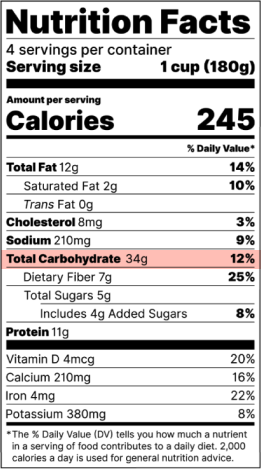The Exchange List System is a simple way to estimate the amount of carbohydrate, protein, and fat in different foods. It works by grouping foods into lists (carbohydrates, fruits, dairy, proteins, and fats) and giving them standard portion sizes. Each portion, or “exchange,” provides about the same amount of macronutrients.
- Carbohydrate, fruit, and dairy exchanges = 15 grams of carbohydrate
- Protein exchange = 6–7 grams of protein
- Fat exchange = 5 grams of fat
This system makes it easier to swap foods within a group while keeping your nutrition balanced.

Carbohydrate Counting
Carbohydrate counting means planning meals around the total grams of carbohydrates you eat. To use it effectively:
- Keep track of the foods and portion sizes you eat.
- Read Nutrition Facts (see image below) carefully—they help you manage carbs more accurately.
- Use a food journal to record not only what you eat, but also how you feel during the day. This can give your dietitian better insights for personal recommendations.
- If you’re using the UnifiedCare app, you can also upload food photos to help track your meals.
The more consistent your tracking, the more personalized your care will be.

How Do Exchanges Work?
Exchanges are not the same as total food weight. For example, a slice of bread may weigh 40 grams, but it counts as only 15 grams of carbohydrate, or one exchange.
Because foods within the same group are equal in their carb, protein, or fat content, you can easily swap them. For example:
- If your Diabetes Educator recommends 3 carb exchanges per meal, you can pick any 3 items from the carbohydrate list below. Each equals 15 grams of carbohydrate.
Examples of Exchanges
1 Carbohydrate Exchange = 15 g carbohydrate (60–80 calories)
- 1 cup or 8 fl oz milk or plain yogurt
- 1/3 cup pasta, couscous, quinoa or rice, barley, beans, lentils
- 1 slice of bread, 1 six-inch tortilla or roti, or 1/2 hamburger or hotdog bun
- 1 tablespoon honey, syrup, or jam
- 1 cup fresh or frozen melon, berries or papaya, 1/2 cup all other fresh or canned fruit
- 4-6 crackers
- 1/2 cup starchy vegetable (peas, potato, yams, corn) or high fiber grain (bulgur, oats)
1 Lean Protein Exchange = 7 g protein (35–40 calories, 1 g fat)
- 1 oz Turkey breast or chicken breast, skin removed
- 1 oz Fish fillet (flounder, sole, tilapia, cod, etc.)
- 1 oz Canned tuna in water
- 1 oz Shellfish (clams, lobster, scallop, shrimp)
- 3/4 cup Cottage cheese, nonfat or low-fat
- 2 Egg whites
- 1/4 cup Egg substitute
- 1 oz Fat-free cheese
- 1/2 cup beans, cooked (black beans, kidney, chickpeas, or lentils)** These count as 1 grain and 1 very lean protein
1 Fat Exchange = 5 g fat (45 calories)
- 1 tsp Oil (vegetable, corn, canola, olive, etc.)
- 1 tsp Butter
- 1 tsp Stick margarine
- 1 tsp Mayonnaise
- 1 Tbsp Reduced-fat margarine or mayonnaise
- 1 Tbsp Salad dressing
- 1 Tbsp Cream cheese
- 2 Tbsp Lite cream cheese
- 1/8 Avocado
- 8 large Black olives
- 10 large Stuffed green olives
- 1 slice Bacon
Putting It Into Practice
Curious about other foods and how they fit into the exchange system? Your dietitian can help tailor the number of exchanges you need each day, based on your health goals and activity level.
The exchange system gives you flexibility—you don’t have to eat the same thing every day. Instead, you can swap foods within each group to keep meals enjoyable while staying on track.



